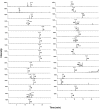Simultaneous LC-MS/MS analysis of eicosanoids and related metabolites in human serum, sputum and BALF
- PMID: 28975688
- PMCID: PMC6003856
- DOI: 10.1002/bmc.4102
Simultaneous LC-MS/MS analysis of eicosanoids and related metabolites in human serum, sputum and BALF
Abstract
The differences among individual eicosanoids in eliciting different physiological and pathological responses are largely unknown because of the lack of valid and simple analytical methods for the quantification of individual eicosanoids and their metabolites in serum, sputum and bronchial alveolar lavage fluid (BALF). Therefore, a simple and sensitive LC-MS/MS method for the simultaneous quantification of 34 eicosanoids in human serum, sputum and BALF was developed and validated. This method is valid and sensitive with a limit of quantification ranging from 0.2 to 3 ng/mL for the various analytes, and has a large dynamic range (500 ng/mL) and a short run time (25 min). The intra- and inter-day accuracy and precision values met the acceptance criteria according to US Food and Drug Administration guidelines. Using this method, detailed eicosanoid profiles were quantified in serum, sputum and BALF from a pilot human study. In summary, a reliable and simple LC-MS/MS method to quantify major eicosanoids and their metabolites was developed and applied to quantify eicosanoids in human various fluids, demonstrating its suitability to assess eicosanoid biomarkers in human clinical trials.
Keywords: COPD; LC-MS/MS; biomarker; eicosanoids.
Copyright © 2017 John Wiley & Sons, Ltd.
Figures



Similar articles
-
HPLC/MS/MS-based approaches for detection and quantification of eicosanoids.Methods Mol Biol. 2009;579:161-87. doi: 10.1007/978-1-60761-322-0_8. Methods Mol Biol. 2009. PMID: 19763475
-
Analysis of eicosanoids by LC-MS/MS and GC-MS/MS: a historical retrospect and a discussion.J Chromatogr B Analyt Technol Biomed Life Sci. 2014 Aug 1;964:79-88. doi: 10.1016/j.jchromb.2014.03.017. Epub 2014 Mar 21. J Chromatogr B Analyt Technol Biomed Life Sci. 2014. PMID: 24742369 Review.
-
Development and validation of a rapid, specific and sensitive LC-MS/MS bioanalytical method for eicosanoid quantification - assessment of arachidonic acid metabolic pathway activity in hypertensive rats.Biochimie. 2020 Apr-May;171-172:223-232. doi: 10.1016/j.biochi.2020.03.010. Epub 2020 Mar 13. Biochimie. 2020. PMID: 32179167
-
Simultaneous profiling and quantification of 25 eicosanoids in human serum by ultrahigh-performance liquid chromatography coupled to tandem mass spectrometry.Anal Bioanal Chem. 2022 Dec;414(29-30):8233-8244. doi: 10.1007/s00216-022-04351-6. Epub 2022 Nov 8. Anal Bioanal Chem. 2022. PMID: 36344666 Free PMC article.
-
Quantification of eicosanoids and their metabolites in biological matrices: a review.Bioanalysis. 2018 Dec;10(24):2027-2046. doi: 10.4155/bio-2018-0173. Epub 2018 Nov 6. Bioanalysis. 2018. PMID: 30412686 Free PMC article. Review.
Cited by
-
Modern Methods of Sample Preparation for the Analysis of Oxylipins in Biological Samples.Molecules. 2019 Apr 25;24(8):1639. doi: 10.3390/molecules24081639. Molecules. 2019. PMID: 31027298 Free PMC article. Review.
-
Metabolic pathways of eicosanoids-derivatives of arachidonic acid and their significance in skin.Cell Mol Biol Lett. 2025 Jan 17;30(1):7. doi: 10.1186/s11658-025-00685-y. Cell Mol Biol Lett. 2025. PMID: 39825220 Free PMC article. Review.
-
Saliva metabolomic profile of COVID-19 patients associates with disease severity.Metabolomics. 2022 Oct 22;18(11):81. doi: 10.1007/s11306-022-01936-1. Metabolomics. 2022. PMID: 36271948 Free PMC article.
-
Ageing: Is there a role for arachidonic acid and other bioactive lipids? A review.J Adv Res. 2018 Feb 15;11:67-79. doi: 10.1016/j.jare.2018.02.004. eCollection 2018 May. J Adv Res. 2018. PMID: 30034877 Free PMC article. Review.
-
A Simultaneous Extraction/Derivatization Strategy for Quantitation of Vitamin D in Dried Blood Spots Using LC-MS/MS: Application to Biomarker Study in Subjects Tested for SARS-CoV-2.Int J Mol Sci. 2023 Mar 13;24(6):5489. doi: 10.3390/ijms24065489. Int J Mol Sci. 2023. PMID: 36982565 Free PMC article.
References
-
- Aghazadeh-Habashi A, Asghar W, Jamali F. Simultaneous determination of selected eicosanoids by reversed-phase HPLC method using fluorescence detection and application to rat and human plasma, and rat heart and kidney samples. Journal of Pharmaceutical and Biomedical Analysis. 2015;110:12–19. - PubMed
-
- Aprikian O, Reynaud D, Pace-Asciak C, Leone P, Blancher F, Monnard I, Mace K. Neonatal dietary supplementation of arachidonic acid increases prostaglandin levels in adipose tissue but does not promote fat mass development in guinea pigs. American Journal of Physiology – Regulatory, Integrative and Comparative Physiology. 2007;293:R2006–R2012. - PubMed
-
- Blewett AJ, Varma D, Gilles T, Libonati JR, Jansen SA. Development and validation of a high-performance liquid chromatography–electrospray mass spectrometry method for the simultaneous determination of 23 eicosanoids. Journal of Pharmaceutical and Biomedical Analysis. 2008;46:653–662. - PubMed
-
- Carrier DJ, Bogri T, Cosentino GP, Guse I, Rakhit S, Singh K. HPLC studies on leukotriene A4 obtained from the hydrolysis of its methyl ester. Prostaglandins Leukotrienes and Essential Fatty Acids. 1988;34:27–30. - PubMed
-
- Chavis C, Fraissinet L, Chanez P, Thomas E, Bousquet J. A method for the measurement of plasma hydroxyeicosatetraenoic acid levels. Analytical Biochemistry. 1999;271:105–108. - PubMed
MeSH terms
Substances
Grants and funding
LinkOut - more resources
Full Text Sources
Other Literature Sources
Miscellaneous

